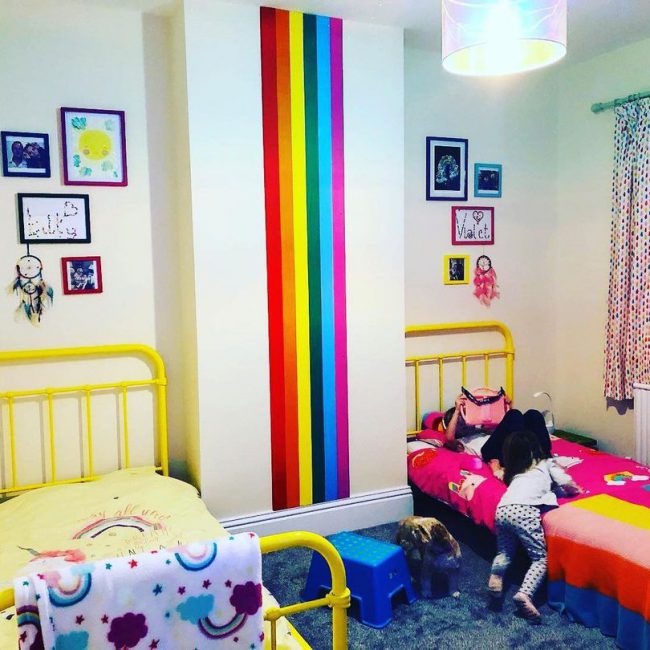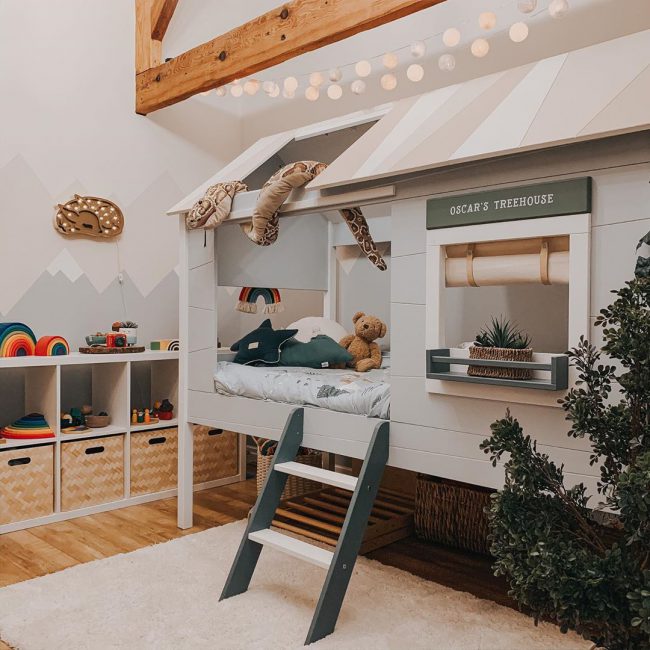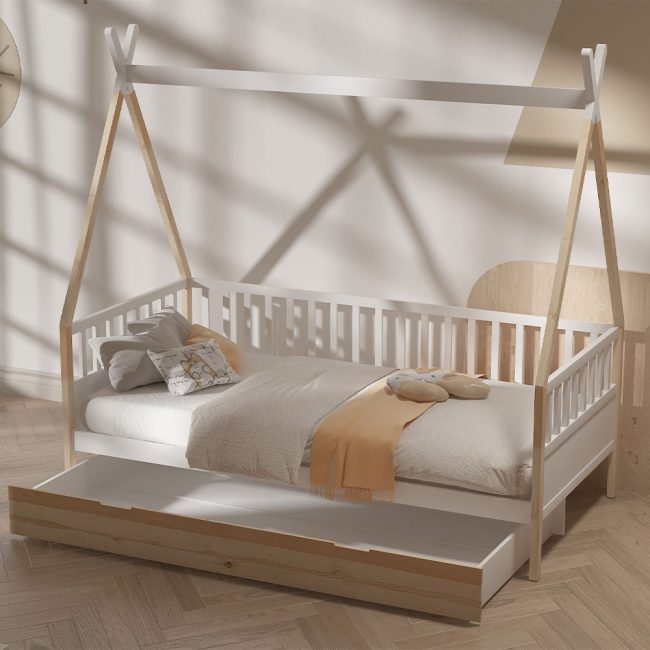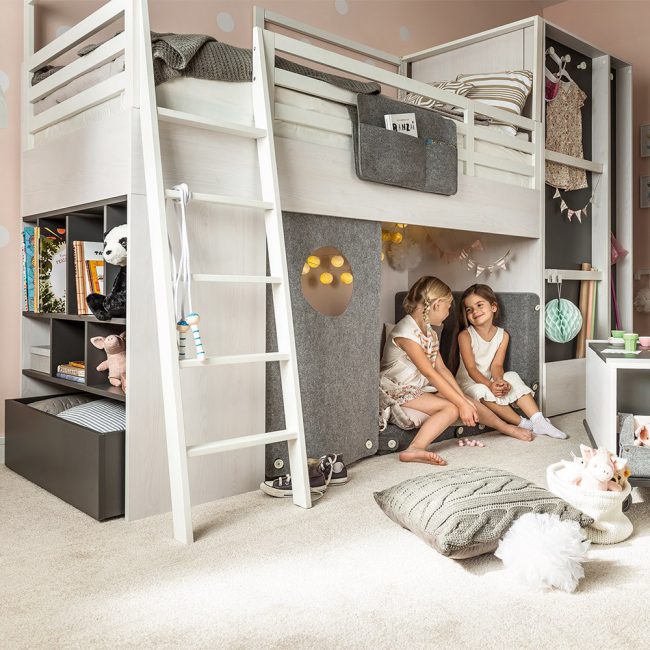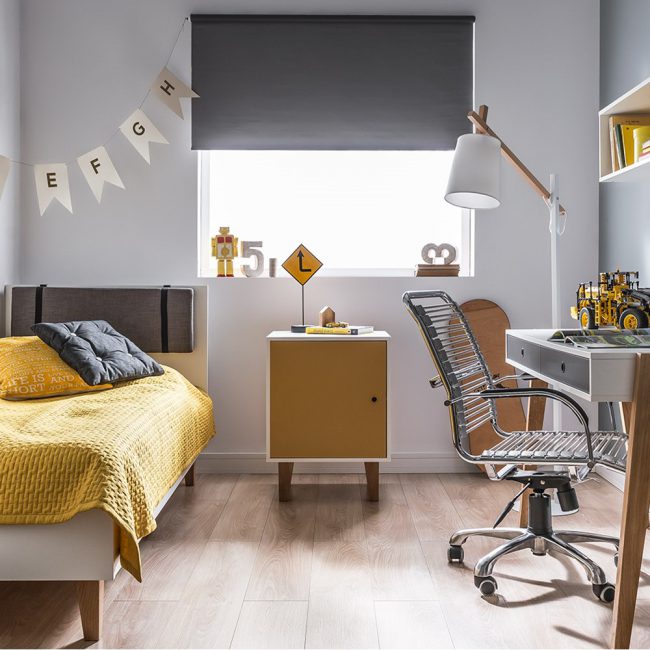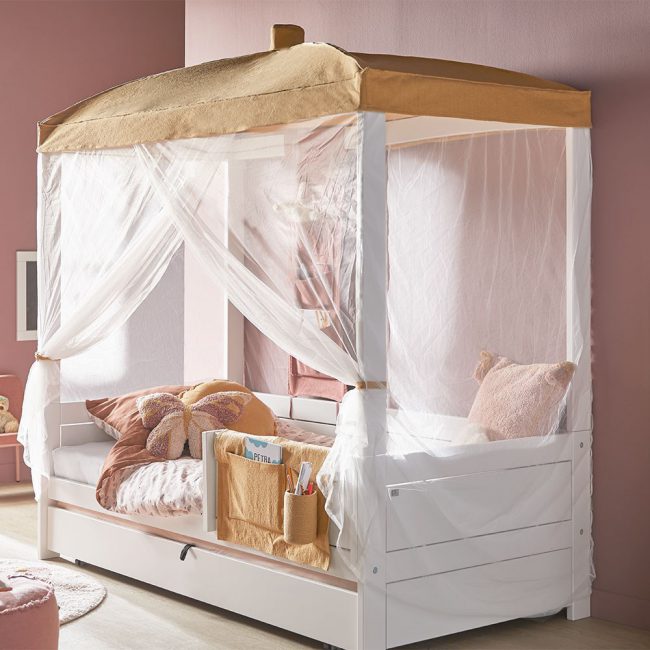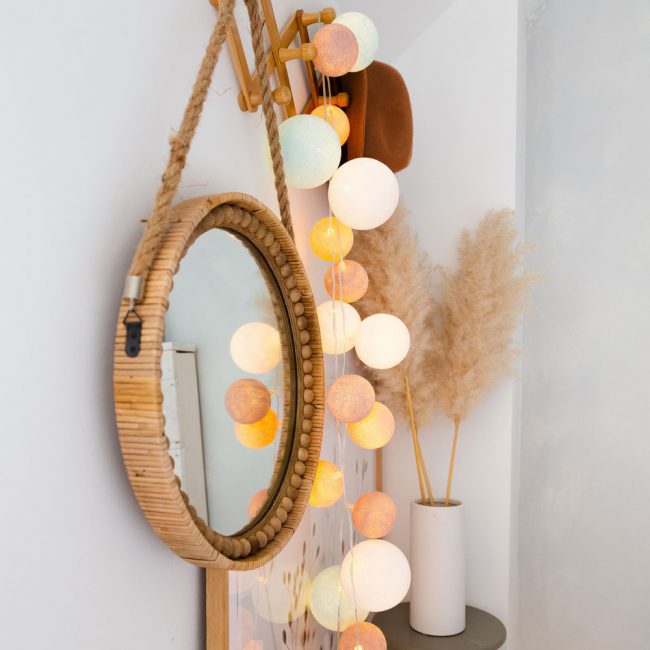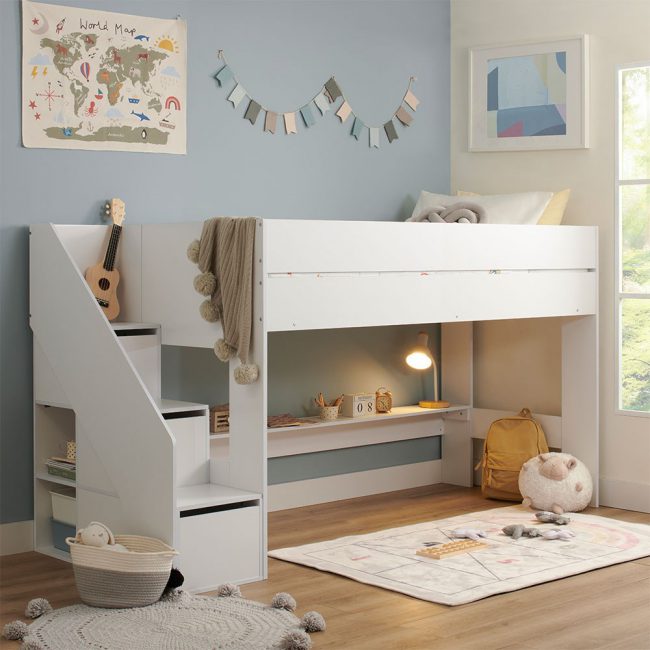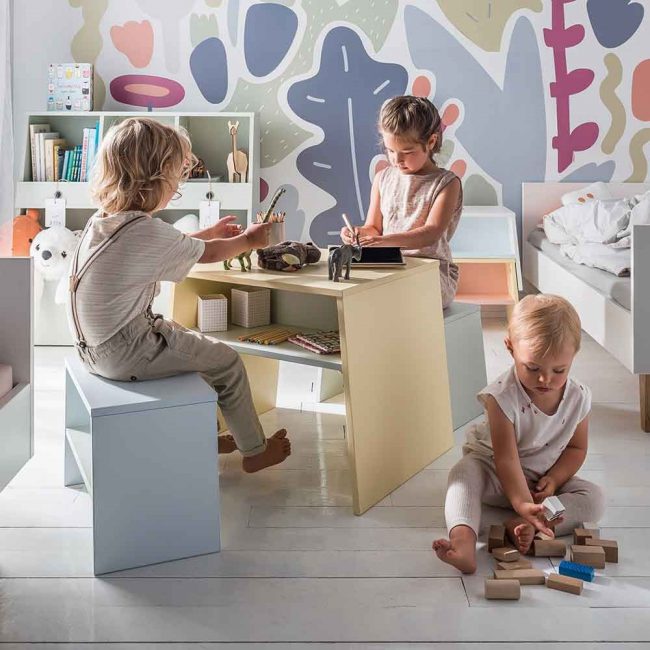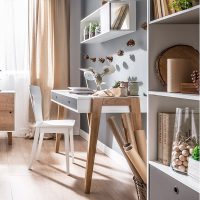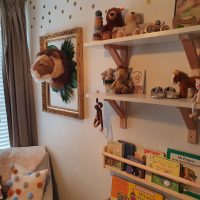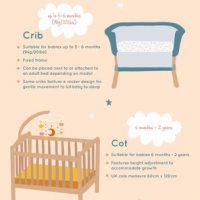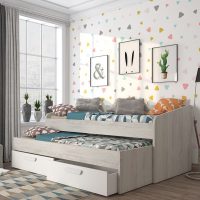How to Consider Children's Mental Health when Designing a Kids Bedroom
Getting ready for a Kid’s Bedroom update? Before you jump right in and dig out your decorating getup, it’s important to first understand the impact design choices can have on children’s mental health!
From understanding colour psychology and selecting wall paints and papers that promote mental well-being, to your kids’ sleep health and picking out the perfect mattress, as well as arranging their furniture into distinct zones to curb clutter and create balance – our ‘How To’ guide will give you the tools you need to get the most out of your kid’s bedroom setup.
Not just a home for their kid’s bed; you’ll be creating their safe space, a relaxing retreat to recharge batteries, a place to express themselves as they grow and a comforting corner away from the stresses of the outside world – a bedroom to just be! By following our list of style rules – our do’s and don’ts of decorating kids’ bedrooms – you’ll have confidence when you start your re-design!
Start with their Bed
Sleep health and mental health go hand-in-hand. To take care of one, you must also take care of the other. Depending on their age and needs, children should be getting anywhere between 9 and 14 hours of sleep in a day, according to the NHS UK. And it’s not just the amount of sleep that can affect children’s mental well-being, the quality of their sleep can too! To care for your child’s sleep hygiene we must look at their sleep setup.
We’ve put together a checklist of things to consider when picking out a Kid’s bed to help achieve a restful and restorative night’s sleep.
- Is the bed the right size and height for their age? Children should be able to safely get in and out of bed independently and have enough space to stretch out and find a comfortable sleeping position.
- Does the mattress fit the bedframe, are there any gaps? Mattresses should perfectly slot into bed frames, avoiding gaps or distorting the mattress shape and forming lumps and bumps. The thickness of the mattress should also be appropriate for the bed type – as an example high sleeper beds should not exceed certain thicknesses to ensure children sleep safely.
- Is the mattress quality compromised? Look out for signs of wear and tear, rips, lumps, uneven surfaces, showing springs, creaking sounds etc. Any red flags like these, and the mattress will need replacing!
- Check the bedding – what materials is it made from? Has it been designed to be breathable and hypoallergenic? Are the sheets machine washable or tumble drier safe? Is the bedding right for the room temperature? Does the bedding protect the mattress from leaks and accidents?
- What pillows are needed? Decide on pillow fillings to suit your child’s needs, especially if they are prone to allergies. Pillows should be supportive and comfortable so children can sleep in the best possible position to avoid physical problems.
Finding the right kid’s bed, mattress and bedding to suit your child can be the difference between them getting a good nights rest and not sleeping at all – which can have a devastating impact on your child’s mental (and physical) health! That’s why we’ve put together additional guides to help with your selection – including Kids Bed Types and Cuckooland’s Mattress Guide.
Create a Bedroom Dedicated to Sleep
Because sleep health and mental health are so closely linked, we’d recommend designing a bedroom that is dedicated to getting forty winks – a calming space, with comfortable bedding, away from distractions. Although, this can be easier said than done – especially when kids get older and their bedrooms become the base for other activities, such as playing, homework and hobbies. When kids start to associate their bedroom with anything other than sleep, it will become more difficult for them to switch off! If their bedroom needs to be used for more than just sleeping, we’d recommend creating zones with their furniture. Cleverly separating their storage, toys, desk and bed – and creating defined areas using room dividers, partitions, shelving and rugs – there won’t be any confusion when they need to get to sleep. And when it’s time for them to hit the pillow, make sure their toys, schoolwork and tech are kept out of sight or hidden away, so they won’t be tempted to stay up!
Screen-free Zone
Another way to promote healthy sleep habits is by going screen-free in the kid’s bedrooms! By screens, we mean phones, smart devices, computers, laptops and any tech that emits harsh blue light. Why? Being exposed to blue light before bed and for extended periods of time can affect our melatonin (sleep hormone) levels and our natural circadian rhythm (our sleep-wake cycle), preventing kids from getting the quality sleep they need. The Sleep Foundation recommend avoiding screens at least one hour before bed (if possible) and winding down with a screen-free activity such as reading or listening to music. Implementing this routine isn’t usually as much of an issue for littluns, but for tweens and teens with their own tech, it starts to become a tricky territory. Choose closed storage so kids can shut distracting devices away, and if totally ditching tech from their bedrooms is a definite no, try getting the whole family involved in the no-screens rule and supporting each other as a unit. If kids can see you setting an example, it’ll be much easier to encourage them to do the same. Plus, you might even see your sleep pattern improve too!
Colour Psychology
Did you know that colours can have a positive and negative impact on our emotional state and mood? Have you ever felt happier around a certain colour? There is a reason for it! Studies have shown, different colours can evoke a range of responses and even access memories and feelings we subconsciously associate with certain shades.
Choosing a colour scheme in the kid’s rooms can have a great influence on their mood if you find the right hue! So, how do you know which shade to go for? We’d start by having a conversation with your kids and finding out which colours they love and which they loathe. If they hate pink and you unknowingly decorate their bedroom from floor to ceiling in bright fuschia, it’s probably not going to go down well… Once you have a rough idea of their likes and dislikes list, you’ll have a good starting point. We’ve listed a few colour groups, and the feelings they’re said to represent, to give you an idea of which to avoid in the kid’s bedrooms!
Red: Bright reds are often associated with danger, anger and energy. Red is also a warm colour and can promote strength, excitement and passion.
Orange: Between red and yellow, orange is associated with energy, focus, positivity, motivation, creativity and warmth.
Yellow: Known to promote happiness, hope, joy, focus and fun. When exposed to the colour yellow, the body can release more serotonin – the happy hormone!
Green: Often representing nature, green promotes calm, relaxation, balance, peace, growth and tranquility. Being exposed to the colour green has also been known to promote healing and reduce anxiety.
Blue: This cool colour is said to be linked with calm, tranquility, peace and offers soothing effects.
Purple: Between red and blue, purple ranges in cool and warm tones. Known to be a spiritual, passionate, inspiring, uplifting and calming colour. Purple has also been shown to reduce heart rates and lower blood pressure.
Pink: Generally considered a thoughtful and gentle colour promoting feelings of optimism. Although this colour has also been known to bring feelings of irritation.
White: Can bring feelings of calm, simplicity, peace and contentment. Can also be associated with cleanliness and feel cold in certain lights.
Black: A strong and sophisticated colour. Can also evoke feelings of sadness and fear.
Of these colours and their variations, we’d recommend avoiding over-stimulating and bright colours in the bedroom and instead opt for a less saturated and softer tone on the walls, ceiling and floors and pick out complimentary accessories and bedding to go with them. It’s also best to avoid bold patterns and clashing tones as these can create a busy backdrop and overload the senses. As an example; If your youngster is adamant about an all-orange bedroom, a gentle, warming shade of orange will create an uplifting atmosphere. Head to your local DIY store and choose a range of samples in varying brightnesses, and test them out in different lights to settle on the perfect mood-boosting colour!
Reduce Pollution
Something to consider when designing the kid’s bedroom update is the pollution! We’re referring to noise, light and air pollution. If you live in a busy city, next to street lights and traffic and you’re finding these levels of pollution are affecting your kids, there are a few things you can try to block out these disturbers!
With noise pollution, both inside and outside the home, reduce the effects by choosing furniture and accessories made of natural materials that will absorb some of the sound. Try to avoid metal and plastic and swap them for furniture made from wood, fabric curtains, textured rugs etc. To combat sound disturbance, especially at night, play white noise or relaxing music to dull out any unwanted background noise.
For light pollution – use blackout curtains or blinds. Not only do they help block out unwanted car headlights, street lights, neighbours lights etc. but they help create a darker and quieter space for sleep. Child-safe sleep masks are also a great alternative if swapping out blinds and curtains isn’t possible. Just make sure they’re age-appropriate, and can easily be removed, should your kids need to. If your kids don’t like sleeping in a completely blacked-out bedroom, provide them with a soft and reassuring night light or mood lighting instead.
Not just for the kid’s rooms, we’d recommend caring for a selection of child-safe air purifying plants to help improve the air quality in your home. Turning airborne toxins into oxygen, many houseplants naturally filter the air we breathe, reduce allergens and improve air quality. Studies have also shown having plants gives us a mood boost too!
If you’re still having trouble with noise, light and air pollution, it’s always best to speak to a specialist or healthcare professional for more information and resources.
Cut the Clutter
Ever heard the phrase, ‘tidy home tidy mind’ and wondered what it meant? It’s been proven that having a tidy and clean living space actually helps improve our mental health! Living in a clutter-free zone can also improve stress levels and increase focus, and cleaning up has even been shown to release happy hormones! When figuring out the layout of the kid’s newly decorated bedrooms and finding their furniture, we’d put storage at the top of the list. By giving kids the space to store their essentials away and keep everything in order, they’ll have the tools they need to keep their bedrooms (and minds) tidy. From wardrobes to dressers, bedside tables, toy boxes, baskets, shelves, bookcases, wall hooks and beds with inbuilt storage – all of their essentials will have a dedicated home and (hopefully) help create order and harmony.
The furniture layout is also important! It can be tempting to cram everything in, stack things up and make use of every inch of space, however, this can create feelings of stress and become overwhelming for kids. Play with their bedroom layout and create clear pathways, easily accessible storage and open spaces to avoid overstuffing! And have a clear-out if their bedroom setup isn’t working. Donate, recycle and rehome and say sayonara to mess and stress!
A Space for Self-Expression
Most importantly, bedrooms are a safe space for kids to express themselves and explore their individuality. Giving kids the freedom to explore who they are, will encourage self-esteem and confidence and relieve stress. This can be done in lots of different ways! Encourage creative hobbies with a crafting desk, nourish learning with a stocked bookcase, show off their artwork around the home, display their achievements on bedroom shelves and hooks or create a dream board filled with photos, goals and ideas. Another lovely idea is to frame family photos and special memories that will instantly bring a smile to their face! Get your kids involved in personalising their bedroom and putting their stamp on their space.
If your kids are bedroom sharing, it can be hard to find common ground. Choose bedding that shows off their individuality, assign shelves and toy boxes for each of them and pick out personalised wall art and decorations that showcase who they are! Give kids the space to grow, explore, change and live their best life!
Kids Bedrooms to Promote Well-Being!
From wall colours to cutting clutter, create a kid’s bedroom that promotes healthy minds! We’ve also listed a few helpful resources below if you’d like to know more and we’d always encourage you to seek out a specialist when discussing your childs well-being. If you’d like to speak to a member of the Cuckooland team for advice, call +44 (0) 1305 231231 or email customerservice@cuckooland.com
Resources:
Sleep hygiene in children and young people | Great Ormond Street Hospital (gosh.nhs.uk)
Color Psychology: Does It Affect How You Feel? (verywellmind.com)
Can Electronics Affect Quality Sleep? | Sleep Foundation
The Mental Health Benefits Of A Clean Home – Forbes Health
Bedroom Environment – The Sleep Charity
Sleep and mental health – Mind
Tips for 11-18 year olds on looking after your wellbeing – Mind
